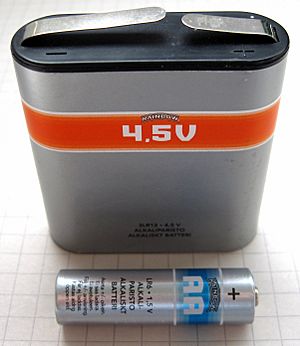Direct current facts for kids
Direct current (DC or "continuous current") is the flow of electricity in a single direction, from the positive to the negative terminals (potential, poles).
The direct current always flow in the same direction, distinguishing it from the alternating current (AC). Direct current used to be called "Galvanic current".
Batteries are some of the main sources of direct current (DC), but many other sources also exist such as bridge rectifiers in power supply, solar panels, etc.
Typically, the current goes through a conductor and other things that can carry DC. DC is also sent through a vacuum as in electron beams or ion beams.
The first commercial electric power transmission was developed by Thomas Edison in the late nineteenth century using direct current. Today nearly all electric power distribution uses alternating current because of the advantages with transformers and transmission. High-voltage direct current is often used for transporting electricity to places far away.
For applications requiring direct current, the alternating current is typically distributed to a substation and then converted to direct current.
Long after the usage of direct current had been established, physicists realized that the current was made of negative electric charges, the electrons, and that the actual flow was from the negative to the positive pole (and so-called "holes" flow in the opposite direction), but by convention, the usage of the term was never changed.
Related pages
Images for kids
See also
 In Spanish: Corriente continua para niños
In Spanish: Corriente continua para niños


